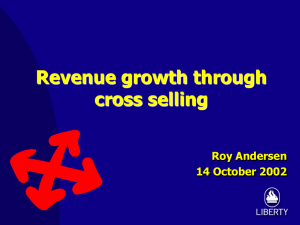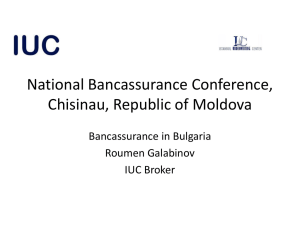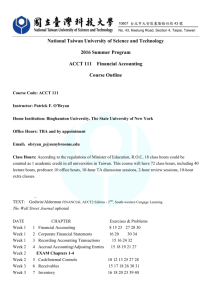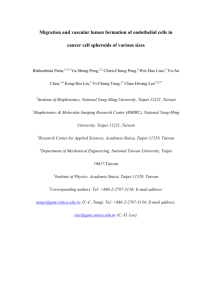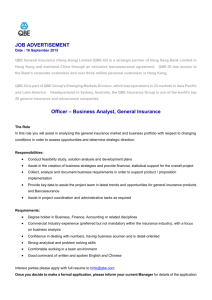International Journal of Application or Innovation in Engineering & Management... Web Site: www.ijaiem.org Email: , Volume 2, Issue 12, December 2013
advertisement
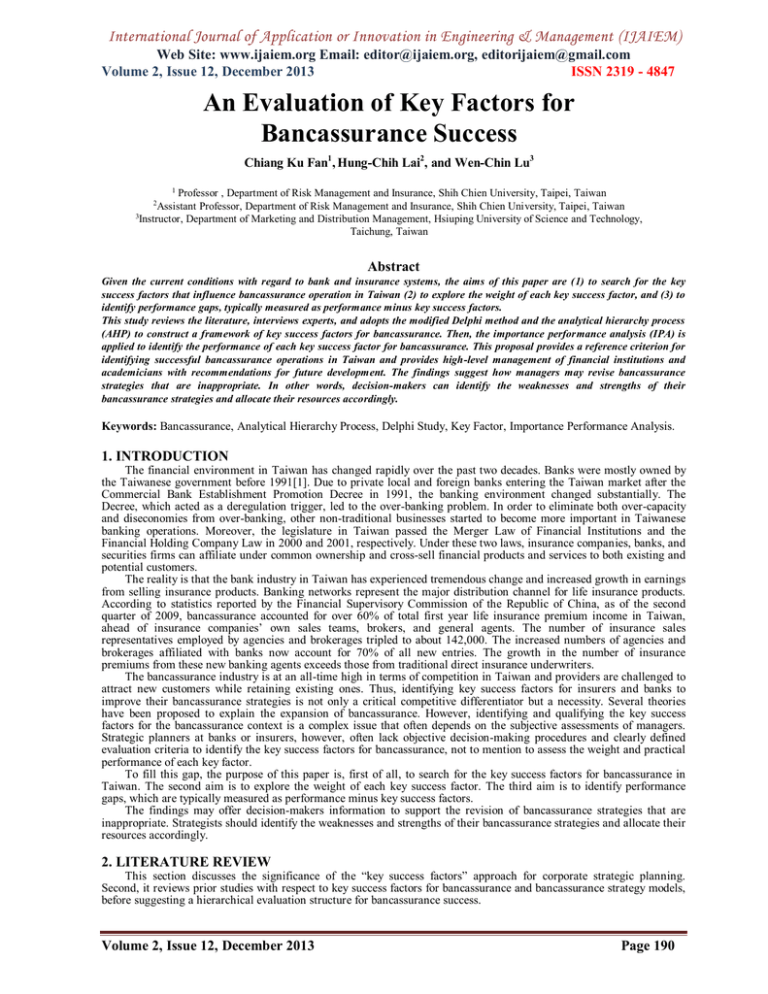
International Journal of Application or Innovation in Engineering & Management (IJAIEM) Web Site: www.ijaiem.org Email: editor@ijaiem.org, editorijaiem@gmail.com Volume 2, Issue 12, December 2013 ISSN 2319 - 4847 An Evaluation of Key Factors for Bancassurance Success Chiang Ku Fan1 , Hung-Chih Lai2, and Wen-Chin Lu3 1 Professor , Department of Risk Management and Insurance, Shih Chien University, Taipei, Taiwan Assistant Professor, Department of Risk Management and Insurance, Shih Chien University, Taipei, Taiwan 3 Instructor, Department of Marketing and Distribution Management, Hsiuping University of Science and Technology, Taichung, Taiwan 2 Abstract Given the current conditions with regard to bank and insurance systems, the aims of this paper are (1) to search for the key success factors that influence bancassurance operation in Taiwan (2) to explore the weight of each key success factor, and (3) to identify performance gaps, typically measured as performance minus key success factors. This study reviews the literature, interviews experts, and adopts the modified Delphi method and the analytical hierarchy process (AHP) to construct a framework of key success factors for bancassurance. Then, the importance performance analysis (IPA) is applied to identify the performance of each key success factor for bancassurance. This proposal provides a reference criterion for identifying successful bancassurance operations in Taiwan and provides high-level management of financial institutions and academicians with recommendations for future development. The findings suggest how managers may revise bancassurance strategies that are inappropriate. In other words, decision-makers can identify the weaknesses and strengths of their bancassurance strategies and allocate their resources accordingly. Keywords: Bancassurance, Analytical Hierarchy Process, Delphi Study, Key Factor, Importance Performance Analysis. 1. INTRODUCTION The financial environment in Taiwan has changed rapidly over the past two decades. Banks were mostly owned by the Taiwanese government before 1991[1]. Due to private local and foreign banks entering the Taiwan market after the Commercial Bank Establishment Promotion Decree in 1991, the banking environment changed substantially. The Decree, which acted as a deregulation trigger, led to the over-banking problem. In order to eliminate both over-capacity and diseconomies from over-banking, other non-traditional businesses started to become more important in Taiwanese banking operations. Moreover, the legislature in Taiwan passed the Merger Law of Financial Institutions and the Financial Holding Company Law in 2000 and 2001, respectively. Under these two laws, insurance companies, banks, and securities firms can affiliate under common ownership and cross-sell financial products and services to both existing and potential customers. The reality is that the bank industry in Taiwan has experienced tremendous change and increased growth in earnings from selling insurance products. Banking networks represent the major distribution channel for life insurance products. According to statistics reported by the Financial Supervisory Commission of the Republic of China, as of the second quarter of 2009, bancassurance accounted for over 60% of total first year life insurance premium income in Taiwan, ahead of insurance companies’ own sales teams, brokers, and general agents. The number of insurance sales representatives employed by agencies and brokerages tripled to about 142,000. The increased numbers of agencies and brokerages affiliated with banks now account for 70% of all new entries. The growth in the number of insurance premiums from these new banking agents exceeds those from traditional direct insurance underwriters. The bancassurance industry is at an all-time high in terms of competition in Taiwan and providers are challenged to attract new customers while retaining existing ones. Thus, identifying key success factors for insurers and banks to improve their bancassurance strategies is not only a critical competitive differentiator but a necessity. Several theories have been proposed to explain the expansion of bancassurance. However, identifying and qualifying the key success factors for the bancassurance context is a complex issue that often depends on the subjective assessments of managers. Strategic planners at banks or insurers, however, often lack objective decision-making procedures and clearly defined evaluation criteria to identify the key success factors for bancassurance, not to mention to assess the weight and practical performance of each key factor. To fill this gap, the purpose of this paper is, first of all, to search for the key success factors for bancassurance in Taiwan. The second aim is to explore the weight of each key success factor. The third aim is to identify performance gaps, which are typically measured as performance minus key success factors. The findings may offer decision-makers information to support the revision of bancassurance strategies that are inappropriate. Strategists should identify the weaknesses and strengths of their bancassurance strategies and allocate their resources accordingly. 2. LITERATURE REVIEW This section discusses the significance of the “key success factors” approach for corporate strategic planning. Second, it reviews prior studies with respect to key success factors for bancassurance and bancassurance strategy models, before suggesting a hierarchical evaluation structure for bancassurance success. Volume 2, Issue 12, December 2013 Page 190 International Journal of Application or Innovation in Engineering & Management (IJAIEM) Web Site: www.ijaiem.org Email: editor@ijaiem.org, editorijaiem@gmail.com Volume 2, Issue 12, December 2013 ISSN 2319 - 4847 2.1 Key Success Factors Approach The key success factors (KSF) approach is a top-down methodology for corporate strategic planning that highlights the key information requirements of top management [2, 3]. Once the key success factors are identified, decision makers have to take action to improve the firm’s competence in the corresponding areas so as ensure success in the market. Rochart (1979) [4] defined critical success factors as the limited number of areas in which results, if satisfactory, will ensure successful competitive performance for the organization. Boynton and Zmud (1984) [5] also defined key success factors as the few things that must go well to guarantee success for an organization. Similar to the previous statement, Thompson and Strickland (2002) [6] consider key success factors to be related to the product properties, assets, competitiveness, and market benefits. They are also closely connected to the profitability of the company. In their view, key success factors are those that managers engaged in each industry must possess if they wish to build a strong competitive competency. In brief, the key success factors will guarantee successful competitive performance because firms can focus their attention on the most critical areas. 2.2 Key Factors for Success in the Bancassurance Context According to the research of Bergendahl (1995) [7], several theories may explain the expansion of bancassurance. The literature regarding the successful key factors for bancassurance remains limited. Benoist (2002) [8] proposed three golden rules for successfully doing business in bancassurance contexts. Specifically, successful bancassurances will be those that are capable of (1) tailoring the model to the context, (2) managing critical success factors, including quality, innovation, short time-to-market of new products, advanced technologies and low costs (3) and, above all, building strong client relationships. The research of Bergendahl (1995) [7] cited four key factors for success in bancassurance. The first key factor focuses on low set-up costs. For example, imagine a subsidiary is established in order to sell life insurance services on a commission basis. In this case, the set-up costs for insurance distribution should be small in relation to the number of customers. The second key factor is rapid sales growth. The premiums are supposed to be somewhat lower for insurance distribution through bank branches than for direct distribution via a traditional distribution channel. Thus, one key to success when entering the insurance market is to establish a substantial market share as early as possible. The third key factor focuses on acceptable outlays for sales promotion. Most services are marketed primarily to customers of the banks. As a consequence, sales promotion costs must not be very large from life insurance companies. The fourth key factor focuses on low administration costs. The administration costs per contract have to be much lower for bank distribution than for direct distribution. However, a controversial survey conducted by Price Waterhouse Coopers, an Economist Intelligence Unit, [9] concluded that agility and speed to market and the ability to develop new and innovative products are keys to success for businesses that wish to diversify into the bancassurance arena. 2.3 Bancassurance Strategy Models As stated in the research of Benoist (2002) [8], the successful bancassurance firms will adopt strategy models that are appropriate to their business environments. Several bancassurance strategies should be developed side-by-side for business success. The difference between the models lies in the level of integration of the various structures. According to research from the OECD (1992) [10], for banks the main structural bancassurance operation may take the form of minority or majority holdings, full-fledged acquisition, creation of subsidiaries, and joint-ventures involving holding companies. Similarly, Benoist (2002) [8] proposed five strategy models for bancassurance success, including marketing partnerships, joint ventures, the creation of integrated groups, mergers and acquisitions, and internal development (captives). Moreover, Sussfeld (2008) [11] claimed that three models can be adopted for bancassurance operation success, including the simple distribution model, joint-venture model, and captive model. A summary of the literature with regard to the key success factors for bancassurance is as follows: (1) The methods employed to identify the key factors of success are not described in papers related to bancassurance. (2) The weight of each key success factor is not defined in prior studies related to bancassurance. (3) No prior research has evaluated the performance of the key success factors for bancassurance contexts. (4) According to various prior studies, certain key success factors for bancassurance and a hierarchical evaluation structure can be identified (see Table 1), including: service quality of the bank, short product innovation cycles, short time to establish a substantial market share by providing lower premium insurances to bank distributions, low subsidiary set-up costs for insurance distribution, large sale promotion from banks, lower administration costs per insurance contract, marketing partnerships, joint ventures, the creation of integrated groups, and internal development. Organizations Insurer Bank Table 1. The Key Factors that underlie Bancassurance Success Key Factors References Benoist (2002) [8] Short product innovation cycle Cooke (2008) [12] Alam (2003) [13] Lower administration cost per Bergendahl (1995) [7] insurance contract Benoist (2002) [8] Providing lower premium insurance to Bergendahl (1995) [7] bank distributions Low subsidiary set-up cost Bergendahl (1995) [7] Volume 2, Issue 12, December 2013 Page 191 International Journal of Application or Innovation in Engineering & Management (IJAIEM) Web Site: www.ijaiem.org Email: editor@ijaiem.org, editorijaiem@gmail.com Volume 2, Issue 12, December 2013 ISSN 2319 - 4847 Service quality Sales promotion Marketing partnerships Strategies of Banks and Insurers Consolidation Joint ventures Creation of integrated groups Internal development Benoist (2002) [8] Bergendahl (1995) [7] Benoist (2002) [8] Benoist (2002) [8] OECD (1992) [10] Sussfeld (2008) [11] Benoist (2002) [8] Benoist (2002) [8] Cooke (2008) [12] 3. METHODOLOGY The methodology in this study consists of three phases (see Figure 1). In the first phase, the key success factors for bancassurance and a hierarchical structure of evaluation are confirmed using the modified Delphi method. In the second phase, the weights of the key factors are calculated by employing the AHP. In the third phase, the gaps between the key factors and their performance are identified using IPA. The major theoretical approaches are described as follows. The First Phase Identify key success factors for bancassurance The 1st Delphi study Develop a hierarchical evaluation structure for identifying the weight of each key success factor The 2nd Delphi study The Second Phase Identify the weight of each key success factor for bancassurance AHP The Third Phase Identify the gap between key success factors and their performance IPA Figure 1. The Structure of the Methodology 3.1 Analytic Hierarchy Process The AHP is a decision-making method that decomposes a complex multicriteria decision problem into a hierarchy [14], AHP is also a measurement theory that priorities the hierarchy and consistency of judgmental data provided by a group of decision makers. AHP incorporates the evaluations of all decision makers into a final decision, without having to elicit their utility functions on subjective and objective criteria, by pairwise comparisons of the alternatives [15]. AHP steps are as follows. 3.1.1 Establish a hierarchical structure Complex issues can be addressed effectively by using a hierarchical structure given the inability of human to compare more than seven categories simultaneously. A hierarchy should not contain more than seven elements. Under this limited condition, a rational comparison can be made and consistency ensured as well [14]. The first hierarchy of a structure is the goal. The final hierarchy involves selecting projects or identifying alternatives, while the middle hierarchy levels appraise certain factors or conditions. 3.1.2 Compute the element weights of various hierarchies A. Establishment of pairwise comparison matrix A. Based on an element of the upper hierarchy that is an evaluation standard, a pairwise comparison is conducted for each element. While n elements are assumed, n(n-1)/2 elements of the pairwise comparison must be derived. Let C1, C2, …, Cn denote the set of elements, while aij represents a quantified judgment on a pair of elements Ci, Cj. The relative importance of two elements is rated using a scale with the values 1, 3, 5, 7 and 9, where 1 refers to ‘equally important’, 3 denotes ‘slightly more important’, 5 equals ‘strongly more important’, 7 represents ‘demonstrably more important’ and 9 denotes ‘absolutely more important’. This yields an n-by-n matrix A as follows: Volume 2, Issue 12, December 2013 Page 192 International Journal of Application or Innovation in Engineering & Management (IJAIEM) Web Site: www.ijaiem.org Email: editor@ijaiem.org, editorijaiem@gmail.com Volume 2, Issue 12, December 2013 ISSN 2319 - 4847 C1 C2 C1 1 a12 1 C 1/ a A aij 2 12 Cn 1/ a1n 1/ a2n Cn a1n a2n 1 (1) The results of the comparison of the n elements are inserted into the upper triangle of pairwise comparison matrix A. The lower triangle values are relative positions for the reciprocal values of the upper triangle. Where aij = 1 and aij = 1/aij, i, j = 1, 2, …, n, two elements (Ci, Cj) become one quantization value for an important relative judgment. In matrix A, aij can be expressed as a set of numerical weights, W1, W2, …, Wn, in which the recorded judgments must be assigned to the n elements C1, C2, …, Cn. If A is a consistency matrix, relations between weights Wi and judgments aij are simply given by Wi and judgments aij are simply given by Wi/Wj = aij (for i,j = 1, 2, …, n) and matrix A as follows: C1 C2 w1 w1 w w2 1 C1 w 1 C 2 A 2 w1 Cn wn wn w2 w1 Cn w1 wn w2 wn 1 (2) B. Compute the eigenvalue and eigenvector Matrix A multiplies the elements weight vector (x) equal to nx i.e., (A- nI)x = 0, where x is the eigenvalue (n) of eigenvector. Given that a ij denotes the subjective judgment of decision makers, the actual value (Wi/Wj) has a certain degree of difference. Therefore, Ax = n.x cannot be set up. Saaty (1990) [15] suggested that the largest eigenvalue λmax would be Wj n max a j 1 ij Wi (3) If A is a consistency matrix, eigenvector X can be calculated by (4) ( A max I ) X 0 C. Perform the consistency test Saaty (1990) [15] proposed utilizing consistency Index (CI) and consistency Ratio (CR) to verify the consistency of the comparison matrix. CI and Random Index (RI) are defined as follows: CI (max n) /(n 1) 0 (5) CR CI / RI (6) where RI represents the average CI over numerous random entries of same order reciprocal matrices. If CR 0.1, the estimate is accepted; otherwise, a comparison matrix is solicited until CR 0.1. D. Compute the entire hierarchical weight After various hierarchies and element weights are estimated, the entire hierarchy weight is computed, ultimately enabling decision makers to identify the weight of each key factor influencing bancassurance success. 3.2 Importance-Performance Analysis In 1977 Martilla and James introduced importance-performance analysis (IPA) as a framework for understanding customer satisfaction as a function of both expectations related to salient attributes (“importance”) and evaluations of their performance (“performance”). The traditional approach for IPA developed by Martilla and James (1977) [16] has been improved in various different ways for specific applications [17, 18] For the hotel sector, the IPA can output a graphical display for the separate measurement of performance versus importance for each factor or attribute. Based on this output, strategists can identify the marketing or operational needs of an organization [2]. Typically, the IPA begins by identifying the critical factors to be evaluated. The factors are based on a literature review or qualitative research [16, 19]. Martilla and James (1977) [16] suggested the use of means to separate each of the two measurements. Importance scores are either above or below the importance mean, and performance scores are either above or below the performance mean [20]. This combination results in four “classification possibilities” [21] including: quadrant 1 (high importance/ low performance)—“concentrate here”, quadrant 2 (high importance/high performance)— “keep up the good work”, quadrant 3 (low importance/low performance)—“low priority”, and quadrant 4 (low importance/high performance)—“possible overkill” (see Figure 2) [16]. Volume 2, Issue 12, December 2013 Page 193 International Journal of Application or Innovation in Engineering & Management (IJAIEM) Web Site: www.ijaiem.org Email: editor@ijaiem.org, editorijaiem@gmail.com Volume 2, Issue 12, December 2013 ISSN 2319 - 4847 High Concentrate here (I) Keep up the good work (II) Low priority (III) Possible overkill (IV) Importance Low Low Performance High Figure 2. IPA Concept Map 4. DECISION MODEL: APPLICATION AND RESULTS In order to identify the key factors and develop an evaluation structure for bancassurance, this study first used a purposive sampling technique to search participants for Delphi study. There are 20 selected participants who are academicians or administrators from different model banks or insurance companies in Taiwan with a known involvement or expertise in bancassurance (see Table 2). No. 1 Title Associate Professor 2 3 Associate Professor Associate Vice President Associate Vice President Junior Managers Assistant Managers General Manager Junior Managers Vice President Vice President Chairman Associate Professor Vice President Assistant Vice President Chief Financial Officer Chief President General Manager 4 5 6 7 8 9 10 11 12 13 14 15 16 17 18 19 20 Assistant Vice President Secretary General Vice President Table 2. Delphi Panelist Institution Department of Risk Management and Insurance, Shih Chien University Department of Insurance, Tamkang University Fubon Life Insurance Area Taipei, Taiwan Taipei, Taiwan Taipei, Taiwan Cathay Life Insurance Taipei, Taiwan China Life Insurance Fubon Life Insurance Hua Nan Financial Holdings Co. Cathay Life Insurance Taiwan Life Insurance China Life Insurance Department of Insurance, Tamkang University Department of Insurance, Tamkang University Eastern Insurance Agency Hua Nan Financial Holdings Co. Taipei, Taiwan Taipei, Taiwan Taipei, Taiwan Taipei, Taiwan Taipei, Taiwan Taipei, Taiwan Taipei, Taiwan Taipei, Taiwan Taipei, Taiwan Taipei, Taiwan Manulife (International )Limited Taipei, Taiwan Cardif Assurance Vie, Taiwan Branch Bancassurance Department,Cathay Life Insurance Eastern Insurance Agency Taipei, Taiwan Taipei, Taiwan The Life Insurance Association of the R.O.C. Shinlong Insurance Co. Ltd Taipei, Taiwan Taipei, Taiwan Taipei, Taiwan 4.1 Results from the First Delphi Study The aim of the first Delphi study was to identify the key success factor for bancassurance. Delphi panelists were asked to provide answers to interview questions and to rate their level of agreement with key factors, ranging from strongly agree (5) to strongly disagree (1). The interview protocol was developed based on a literature review. The interview explored more fully the perceptions of experts regarding the key success factors for bancassurance. These qualitative responses helped to elaborate quantitative responses to the standardized questions, and qualitative themes that were representative of opinions expressed by a large majority of the Delphi panelists. Descriptive statistics regarding the attitudes toward each key factor as identified at interview are listed in Table 3. In the final round, nineteen Delphi panelists strongly agreed that “short product innovation cycles”, “service quality”, “sales promotion”, and “internal development” were key success factors for bancassurance. Moreover, eighteen Delphi panelists strongly agreed that “lower administration cost per insurance contract”, “low subsidiary set-up cost”, “marketing partnerships”, and “the creation of integrated groups” were key success factors for bancassurance. There were no undecided, disagree or strongly disagree answers for key factors in round 3. Volume 2, Issue 12, December 2013 Page 194 International Journal of Application or Innovation in Engineering & Management (IJAIEM) Web Site: www.ijaiem.org Email: editor@ijaiem.org, editorijaiem@gmail.com Volume 2, Issue 12, December 2013 ISSN 2319 - 4847 Table 3. Descriptive Statistics for Attitudes Toward Each Key Factor in Interview Rounds 2 and 3 Attitude toward Key factors Key factors SA R2 A R3 UD D SD R2 R3 R2 R3 R2 R3 R2 R3 Short product innovation cycles 18 19 2 1 0 0 0 0 0 0 Lower administration cost per insurance contract 17 18 2 2 1 0 0 0 0 0 Providing lower premiums insurance bank distributions 16 17 3 3 1 0 0 0 0 0 Low subsidiary set-up cost 17 18 2 2 1 0 0 0 0 0 Service quality 17 19 3 1 0 0 0 0 0 0 Sales promotions 18 19 2 1 0 0 0 0 0 0 Marketing partnerships 18 18 2 2 0 0 0 0 0 0 Joint ventures 16 17 3 3 1 0 0 0 0 0 Creation of integrated groups 17 18 2 2 1 0 0 0 0 0 Internal development 18 19 2 1 0 0 0 0 0 0 *Five Attitudes toward Key Success Factors: Strongly Agree (SA), Agree (A) Undecided (UD), Disagree (D), and Strongly Disagree (SD). Based on the results of a Wilcoxon Signed Rank test, no significant attitude differences toward each key success factor were identified when comparing round 2 to round 3. Thus, the 10 items proposed by this study should be identified as key success factors for bancassurance. 4.2 Results from the Second Delphi Study The aim of the second Delphi study was to develop a hierarchical evaluation structure to calculate the weight of each key success factor. Delphi panelists were asked to justify their answers to interview questions and to rate their level of agreement with the hierarchical evaluation structure developed by this research (see Figure 3). Figure 3. Evaluative Framework to Calculate the Weight of Each Key Success Factor for Bancassurance Nineteen experts agreed on this evaluation structure in the second round of interviews based on the results of the Wilcoxon Signed Rank test, and no significant differences in attitude toward the hierarchical evaluation structure were found between round 1 and round 2. Therefore, no further interview rounds were deemed necessary. Accordingly, the hierarchical evaluation structure suggested by this study was identified as a suitable mode to evaluate bancassurance success. 4.3 Results from the Analytic Hierarchy Process The AHP questionnaire was developed based on the results from the second Delphi study and was distributed to 20 Delphi panelists. Following data collection, the criteria weights for evaluating bancassurance success in Taiwan were obtained from the AHP process. According to Table 4, the most important criterion was the bank (W=0.394). Among the criteria for the insurer, bank, and strategies of bank and insurers consolidation, the most important sub-criteria were short product innovation cycles (W=0.420), sales promotions (W=0.434), and marketing partnerships (W=0.329), respectively. Volume 2, Issue 12, December 2013 Page 195 International Journal of Application or Innovation in Engineering & Management (IJAIEM) Web Site: www.ijaiem.org Email: editor@ijaiem.org, editorijaiem@gmail.com Volume 2, Issue 12, December 2013 ISSN 2319 - 4847 Furthermore, sales promotions (W=0.146), marketing partnerships (W=0.130), and short product innovation cycles (W=0.113) were the three most important sub-criteria. Table 4. Weights of the Criteria and Sub-Criteria in Taiwan Criteria Criteria Weights Sub-Criteria 0.270 Insurer Bank 0.394 Strategy of bank and insurers consolidation 0.336 Sub-Criteria Weights Total Weights Short product innovation cycles 0.42 0.113 Lower administration cost per insurance contract 0.316 0.085 Providing lower premium insurance to bank distribution 0.264 0.071 Low subsidiary set-up cost 0.262 0.088 Service quality Sales promotions Marketing partnerships Joint ventures Creation of integrated groups Internal development 0.304 0.434 0.329 0.228 0.271 0.172 0.102 0.146 0.130 0.090 0.107 0.068 4.4 Results from the Importance-Performance Analysis The purpose of the attitude survey was to collect data with regard to the performance of each key success factor. The respondents were asked to comment on the performance of each key success factor for bancassurance. Using the snowball sampling technique, the questionnaires were distributed to qualified managers who were introduced or recommended by other managers because of their job experience in bancassurance. This study successfully surveyed 30 qualified managers employed by different banks and insurance companies in Taiwan. As stated in the methodology section, rating levels in the performance survey extended from one to five. However, the range of weights estimated using AHP only extended from zero to one. In order to conduct a comparison, this study transformed the key factor weights to a 1 to 5 scale. Table 5. Gap Analysis of Key Factors and Performance in Taiwan Item 1 2 3 Key Factors Key Factor Weights (after Linear Transformation) (A) Mean of Performance (B) Gap Analysis (B-A) 2.81 4.25 1.44 2.36 2.00 -0.36 2.14 2.25 0.11 2.41 4.00 1.59 2.63 3.00 0.37 3.34 3.25 -0.09 3.08 4.00 0.92 2.44 3.00 0.56 2.71 3.75 1.04 2.09 3.25 1.16 2.60 3.28 0.68 Short product innovation cycles Lower administration cost per insurance contract Providing lower premium insurance to bank distribution 4 Low subsidiary set-up cost 5 Service quality 6 Sales promotions 7 Marketing partnerships 8 Joint ventures 9 Creation of integrated groups 10 Internal development Overall Table 5 suggests that the means of key factor weights and their performance ratings in bancassurance in Taiwan were 2.60 and 3.28, respectively. Table 5 also calculates the gap between the key factor weights and their performance. If the gap is negative, the key factor performance is less than its weight. On the other hand, if the gap is positive, the key factor performance is greater than its weight. Volume 2, Issue 12, December 2013 Page 196 International Journal of Application or Innovation in Engineering & Management (IJAIEM) Web Site: www.ijaiem.org Email: editor@ijaiem.org, editorijaiem@gmail.com Volume 2, Issue 12, December 2013 ISSN 2319 - 4847 Figure 4. Importance-Performance Grid for Taiwan According to the grid for Taiwan (see Figure 4), a total of two key success factors fell into the area of “concentration” (quadrant (I)). These factors included sales promotions (3.25, 3.34) and service quality (3, 2.63). Furthermore, the three key success factors located in quadrant (II) were short product innovation cycles (4.25, 2.81), marketing partnerships (4, 3.08), and the creation of integrated groups (3.75, 2.71). Management should “keep up the good work”. In addition, three key success factors were plotted in the “low priority” area (quadrant (III)). Examples are lower administration cost per insurance contract (2, 2.36), providing lower premium insurance to bank distribution (2.25, 2.14), joint ventures (3, 2.44), and internal development (3.25, 2.09). Only one key success factor fell within the area of “possible overkill” (quadrant (IV)): low subsidiary set-up cost (4, 2.41). 5. CONCLUSION The purpose of this study was to identify key factors that may influence bancassurance success in Taiwan. The above analysis supports the argument that, while it is necessary to identify areas of importance and low performance, neither is sufficient alone. Just because a key factor is important does not mean that resources should be expended on that key factor; performance may be adequate, in which case benefits will be limited for the resources expended. In Taiwan, factors such as sales promotion and service quality fall into quadrant (I) and are perceived as more important but poorly performed in bancassurance contexts. The managerial implication is that management needs to improve performance in terms of these key factors. Key factors such as short product innovation cycles, marketing partnerships, and the creation of integrated groups were located in quadrant (II) and were rated as being important and exhibiting a high level of performance. Management should maintain the performance of these key factors to sustain the consequent competitive advantage (see Figure 5). Figure 5. Resource Allocation in Taiwan The key factors of lower administration cost per insurance contract, providing lower premium insurance to bank distribution, joint ventures, and internal development were in quadrant (III) and were considered to have low importance and low performance. Management need not improve performance for these key factors (see Figure 5). The key factor involving low subsidiary set-up costs appeared in quadrant (IV) and was perceived as less critical to success, although bancassurance generally performed well in this key factor. This may indicate over-investment in a less critical area, and a reduction in investment may be appropriate (Figure 5). In order to reallocate resources and to improve the performance of bancassurance, administrators should have certain efforts originally invested in some key factors (including lower administration cost per insurance contract, providing lower premium insurance to bank distribution, joint ventures, internal development, and low subsidiary set-up costs) moved to support the key factors of sales promotions and service quality . However, the administrator should not expand resources to support the key factors of short product innovation cycles, marketing partnerships, and the creation of integrated groups (Figure 5). REFERENCES [1] T. Y. Chen, T. H. Yeh, “Study of Efficiency Evaluation in Taiwan’s Banks,” International Journal of Service Industry Management 9 (5):402-415, 1998. Volume 2, Issue 12, December 2013 Page 197 International Journal of Application or Innovation in Engineering & Management (IJAIEM) Web Site: www.ijaiem.org Email: editor@ijaiem.org, editorijaiem@gmail.com Volume 2, Issue 12, December 2013 ISSN 2319 - 4847 [2] C. Y. Li, C. S. Wong, T. K. Luk, “The Importance and Performance of Key Success Factors of International Joint Venture Hotels in China,” The Chinese Economy 39 (6):83-94, 2006. [3] C. Byers, D. Blume, “Tying Critical Success Factors to Systems Development,” Information and Management Amsterdam 26 (1):51–61, 1994. [4] J.F. Rochart, “Chief Executives Define Their Own Data Needs,” Harvard Business Review 57 (2):81–92, 1979. [5] A. Boynton, R. Zmud, “An Assessment of Critical Success Factors,” Sloan Management Review 25 (4):17–27, 1984. [6] A. Thompson, A. J. Strickland, ”Strategic Management Concept and Cases”, McGraw Hill, New York, 2002. [7] G. Bergendahl, “The Profitability of Bancassurance for European banks,” International Journal of Bank Marketing 13 (1):17-29, 1995. [8] G. Benoist, “Bancassurance: The new challenges,” The Geneva Papers on Risk and Insurance 27 (3):95-303, 2002. [9] “Survey Finds Move Into Financial Service May Present Challenge to P&C Insurers,” Insurance Advocate 111 (14):8, 2000. [10] OECD, Insurance and other Financial Service: Structural Trends. ”Paris: The Organization for Economic Cooperation and Development”, 1992. [11] V. Sussfeld, The trend of European Bancassurance market and product. ”Bancassurance Seminar 2008 Win- Win for Bank and Insurance”, Taipei, Taiwan, 2008. [12] F. L. Cooke, “Competition and Strategy of Chinese firms,” Competitiveness Review, An International Business Journal 18 (1/2):29-56, 2008. [13] I. Alam, “Innovation Strategy, Process and Performance in the Commercial,” Journal of Marketing Management 19:973-999, 2003. [14] T. L. Saaty, The Analytic Hierarchy Process. ”New York: McGraw Hill Publications”, 1980. [15] T. L. Saaty, “How to Make a Decision: The Analytic Hierarchy Process,” European Journal of Operational Research 48 (1):9-26, 1990. [16] J. Martilla, J. James, “Importance - Performance Analysis,” Journal of Marketing 41 (1):77–99, 1977. [17] T. Albrecht, H. Bradford, “Relational and Content Differences between Elites and Outsiders in Innovation Networks,” Human Communication Research 17 (4):535–546, 1991. [18] J. Crompton, N. Duray, “An Investigation of the Relative Efficacy of Four Alternative Approaches to ImportancePerformance Analysis,” Academy of Marketing Science 13 (4):69–80, 1985. [19] W. Skok, A. Kophamel, I. Richardson, “Diagnosing Information Systems Success: Importance-Performance Maps in the Health Club Industry,” Information & Management 38:409–419, 2001. [20] S. E. Sampson, M. J. Showalter, “The Performance-Importance Response Function: Observations and Implications,” The Services Industries Journal 19 (3):1–25, 1999. [21] D. Mount, “An Empirical Application of Quantitative Derived Importance-Performance Analysis for Employee Satisfaction,” Journal of Quality assurance in Hospitality and Tourism 6 (1/2):65-76, 2005. Volume 2, Issue 12, December 2013 Page 198
